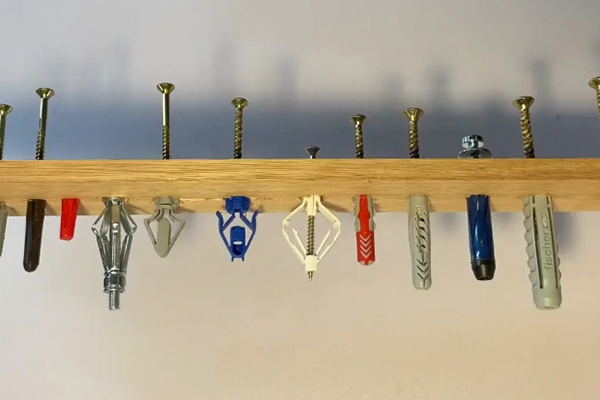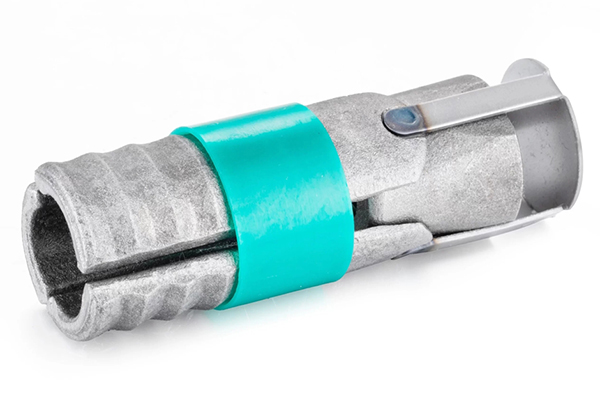This article is your one-stop resource for understanding everything about drywall anchors, with a special focus on self-drilling drywall anchors. We'll cover how to choose the right anchor, installation techniques, and tips for achieving a secure and reliable hold, even for heavy-duty applications. Whether you're a seasoned contractor or a DIY enthusiast, this guide provides the knowledge you need to confidently tackle any wall-hanging project, making it a truly worthwhile read.
1. What are Drywall Anchors and Why Do You Need Them?
Drywall, also known as gypsum board or sheetrock, is a common building material used for interior walls and ceilings. While it's convenient and versatile, drywall itself is relatively weak and brittle. Trying to hang anything heavier than a very light picture frame directly into drywall with just a screw is a recipe for disaster. The screw will likely pull out, damaging the wall and potentially causing the item to fall.
This is where drywall anchors come in. A drywall anchor is a fastener that expands or grips the drywall, providing a much more secure hold than a screw alone. They distribute the weight of the object being hung over a larger area of the drywall, preventing the screw from tearing through. Think of it like this: a screw alone is like standing on your tiptoes – all the weight is concentrated in a small area. An anchor is like standing flat-footed – the weight is spread out, making you much more stable. Using a correct wall anchor is the key to secure install.
2. Different Types of Drywall Anchors: Pros and Cons
There are several types of drywall anchors available, each with its own strengths and weaknesses. Understanding these differences is crucial for choosing the right type of anchor for your project.
- Plastic Expansion Anchors: These are inexpensive and suitable for light-duty applications, like small picture frames. They expand as the screw is inserted, creating a grip within the drywall. However, they are not suitable for heavy-duty items.
- Toggle Bolts: Toggle bolts are the strongest type of drywall anchor. They consist of a bolt with a spring-loaded, winged toggle that folds flat to be inserted into a pre-drilled hole. Once inside the wall, the wings open, providing a very secure hold. These are ideal for heavy items like shelves or TVs. The drawback is that they require a larger hole.
- Molly Bolts: Molly bolts are a type of expansion anchor that provides a more secure hold than plastic expansion anchors. They have a metal sleeve that expands behind the drywall as the screw is tightened. They're good for medium-weight items.
- Self-Drilling Drywall Anchors: These anchors combine the ease of installation of a plastic expansion anchor with a stronger hold. They have a sharp, threaded point that allows them to be screwed directly into the drywall without the need for pre-drilling. We'll explore these in more detail in the next section.
| Anchor Type | Pros | Cons | Weight Capacity (Approximate) |
|---|---|---|---|
| Plastic Expansion | Inexpensive, easy to install | Low holding strength, not for heavy-duty items | Up to 10 lbs |
| Toggle Bolt Anchors | Very strong, ideal for heavy items | Requires a large hole, can be difficult to install | Up to 100 lbs+ |
| Molly Bolts | Stronger than plastic expansion anchors, good for medium-weight items | Requires pre-drilled holes, can be difficult to remove | Up to 50 lbs |
| Self-Drilling Anchors | Easy to install, no pre-drilling needed, stronger than plastic expansion | Not as strong as toggle bolts, may not be suitable for very heavy items | Up to 75 lbs |
3. Self-Drilling Drywall Anchors: A Deep Dive
Self-drilling drywall anchors, sometimes called "zip-its" or "E-Z Ancors," are a popular choice because they are incredibly easy to install. They eliminate the need to drill a hole beforehand. These anchors feature a sharp, pointed end and coarse threads that allow them to bore directly into the drywall. As the anchor is screwed in, the threads cut into the gypsum board, creating a secure hold.
Most self-drilling drywall anchors are made of either zinc (a strong metal) or nylon (a durable plastic). Zinc plated anchors are generally stronger and more suitable for heavier items. The thread design of these anchors is crucial to their holding power. The deep, coarse threads provide a larger surface area for gripping the drywall. They are perfect for installing a multitude of items, and are very easy to install.
4. How to Choose the Right Self-Drilling Drywall Anchor?
Choosing the right self-drilling drywall anchor depends on several factors:
- Weight of the Item: This is the most critical factor. Always check the anchor's packaging for its weight capacity rating. Choose an anchor that can support at least the weight of the item you're hanging, and ideally, a bit more for added safety. A quality drywall anchor screw is crucial.
- Drywall Thickness: Drywall typically comes in 1/2-inch and 5/8-inch thicknesses. Most anchors are designed for 1/2-inch drywall, but some are compatible with both thicknesses. Check the packaging to be sure.
- *Material (Zinc vs. Nylon): Zinc anchors are generally stronger and more durable than nylon anchors. They are better suited for heavier items or applications where the anchor may be subjected to stress. Nylon anchors are a good choice for lighter items and are less likely to damage the drywall if overtightened.
- Anchor Size and length of provided screw. If you need anchors with screw, ensure the provided screw is long enough.
5. Step-by-Step Guide: Installing Self-Drilling Drywall Anchors with Screws
Installing self-drilling drywall anchors with screws is a straightforward process:
- Mark the Location: Use a pencil to mark the exact spot where you want to install the anchor.
- Position the Anchor: Place the pointed tip of the self-drilling anchor on the mark.
- Drive the Anchor: Using a Phillips head screwdriver (most self-drilling anchors have a Phillips head), apply firm, steady pressure and begin screwing the anchor into the drywall. The anchor's sharp point and threads will do the work of boring the hole. Continue screwing until the anchor is flush with the wall. Do not overtighten, as this can damage the drywall.
- Insert the Screw: Once the anchor is in place, insert the screw into the anchor hole and tighten the screw until it is snug. Again, avoid overtightening. Customers like the straightforward nature of the process.
That's it! You've successfully installed a self-drilling drywall anchor. These steps apply for all of the pcs self drilling drywall anchors.
6. Heavy-Duty Applications: When to Use More Than a Standard Drywall Anchor?
While self-drilling drywall anchors are suitable for many applications, there are times when you need something stronger. For heavy-duty applications, such as hanging large mirrors, heavy shelves, or TVs, you should consider using toggle bolt anchors or heavy duty metal anchors.
Another option for added support is to locate a stud (a vertical framing member within the wall). Screwing directly into a stud provides the strongest possible hold. However, studs are not always conveniently located where you need them. If you can't find a stud, or if the item you're hanging needs to be positioned between studs, a heavy-duty drywall anchor is essential. Always choose the strongest possible fastener. Consider a drywall anchors and screws kit for heavy applications.
7. Zinc vs. Plastic Drywall Anchors: Which is Better?
As mentioned earlier, self-drilling drywall anchors are commonly made of either zinc or plastic (usually nylon). Here's a comparison:
-
Zinc Drywall Anchors:
- Pros: Stronger, more durable, higher weight capacity, resistant to corrosion (zinc plated).
- Cons: Can be more expensive than plastic anchors, can potentially damage the drywall if overtightened.
-
Plastic Drywall Anchors (Nylon):
- Pros: Less expensive, less likely to damage the drywall, suitable for light to medium-weight items.
- Cons: Lower weight capacity, not as durable as zinc anchors. Plastic plugs are often seen as inferior.
The best choice depends on your specific needs. For heavier items or applications where durability is critical, zinc is the better option. For lighter items and situations where cost is a major concern, plastic anchors are a viable choice. Plastic anchors can be acceptable.
8. Troubleshooting Common Drywall Anchor Problems
Even with careful installation, you may encounter some problems with drywall anchors. Here are a few common issues and how to address them:
- Anchor Pulls Out: This usually happens if the anchor is overloaded or if it was not installed correctly. If the anchor pulls out, you'll need to repair the anchor hole (using a patching compound) and choose a stronger anchor or a different installation location.
- Anchor Spins in the Wall: This can happen if the drywall is too thin or soft, or if the anchor was overtightened. Try using a slightly larger anchor or a different type of anchor (such as a toggle bolt).
- Screw Won't Tighten: This can occur if the anchor is damaged or if the screw is stripped. Try using a new anchor and screw. If the problem persists, you may need to use a larger screw or a different type of anchor. Consider using an expansion screw.
- Anchor is sticking out: Ensure that the anchor is flush with the wall surface.
9. Drywall Anchors and Safety: Best Practices
While drywall anchors are generally safe to use, there are a few safety precautions to keep in mind:
- Always Wear Eye Protection: When drilling or screwing into drywall, small particles of gypsum can fly off. Wear safety glasses to protect your eyes.
- Check for Wires and Pipes: Before drilling or screwing into a wall, use a stud finder with AC wire detection to check for hidden electrical wires or plumbing pipes. Hitting a wire or pipe can be dangerous and cause significant damage.
- Don't Overload Anchors: Always adhere to the weight capacity ratings of the anchors. Overloading an anchor can cause it to fail, potentially leading to injury or property damage.
- Use the correct screw: Always use the provided or recommended screw size for the anchor.
10. Beyond Drywall: Can These Anchors Be Used on Other Materials?
While self-drilling drywall anchors are primarily designed for use on drywall, some types can also be used on other materials, such as plaster or plaster board. However, it's essential to check the anchor's packaging to confirm its suitability for other materials. The holding power of the anchor will vary depending on the material's density and strength. For materials like concrete or brick, you'll need specialized anchors designed for those materials. Do not attempt to force a drywall anchor to function as something it's not.
11. The Future of Drywall Anchors: Innovations and Trends
The world of drywall anchors is constantly evolving. Manufacturers are continually developing new and improved anchors that are stronger, easier to install, and more versatile. Some recent innovations include:
- Self-Tapping Anchors: These anchors have even sharper points and more aggressive threads, making them even easier to install in drywall.
- High-Strength Anchors: New materials and designs are leading to anchors with significantly higher weight capacities.
- Adjustable Anchors: These anchors allow for some adjustment after installation, making it easier to position the item being hung perfectly.
- Combination Kits: Buying sets like the drywall anchors and screws assortment is becoming more popular.
As technology advances, we can expect to see even more innovative drywall anchor solutions in the future. This applies to more advanced items like toggle bolts and wing nut kit and the bolts and wing nut kit.
Allen here, from our factory in China. We're committed to providing the highest quality self-drilling anchor systems. We follow strict quality control measures, adhering to international standards like ISO, to ensure our products are reliable and durable. My customers, like Mark Davis in the USA, often express concerns about quality inspection, logistics, and communication. We address these concerns head-on. We have seven production lines, and export to major markets like the USA, North America, Europe, and Australia.
For example, using high-quality carbon steel is one of the key ways we provide the heavy duty products our customers demand. For Mark, and others purchasing self-drilling anchor tools and related equipment (like anchor bars, anchor bits, and anchor nuts), clear and efficient communication is paramount. I make sure to be decisive and lead conversations, addressing his concerns directly. We understand that shipment delays can be a major pain point, so we work diligently to ensure timely delivery.
For B2B clients in construction, mining, and tunneling, we offer a comprehensive range of products, including anchor couplers, anchor plates, centralizers, split set rock bolts, Swellex anchor bolts, fiberglass bolts, resin and cement cartridges, mesh straps & plate washers, and thread bars. We also offer related drilling equipment like tapered drill rods, extension drill rods, drill button bits, integral rods, and shank adapters.
We also have a wide array of products to support all kinds of projects. Washer products are useful in many applications. Consider also our range of Nut options. And check out our Bolt products.
For technical details and specifications, we always provide comprehensive documentation, including relevant certifications. This transparency helps build trust and ensures our clients know exactly what they're getting. We understand the procurement process and strive to make it as smooth as possible.
Key Takeaways:
- Drywall anchors are essential for securely hanging items on drywall.
- Self-drilling drywall anchors offer easy installation without pre-drilling.
- Choose the right anchor based on the weight of the item and the type of drywall.
- Zinc anchors are generally stronger than plastic anchors.
- For heavy-duty applications, consider toggle bolts or stud mounting.
- Always follow safety precautions when installing drywall anchors.
- The selected delivery location must always be checked carefully.
- When seeking suppliers, focus on clear communication and check all certifications.
- We often see customers like easy and efficient service.
This comprehensive guide has equipped you with the knowledge and confidence to tackle any drywall hanging project. Remember, using the right anchor and following proper installation techniques are key to achieving a secure and lasting hold.
Post time: 3 月-12-2025
















